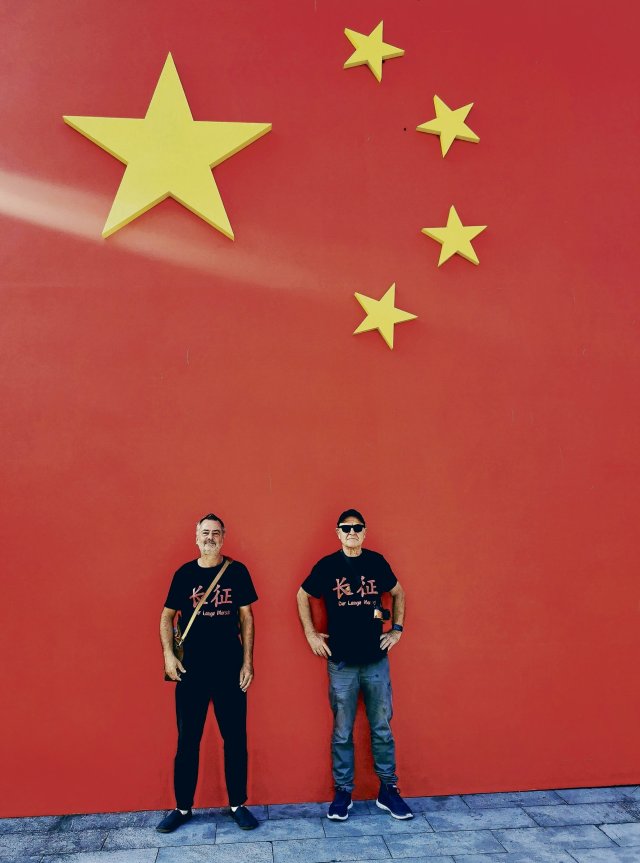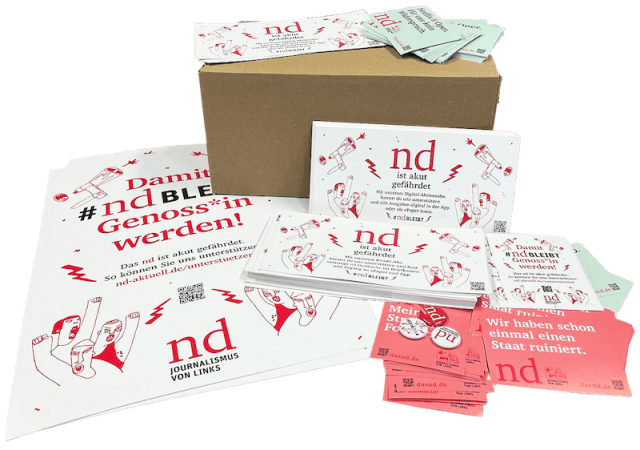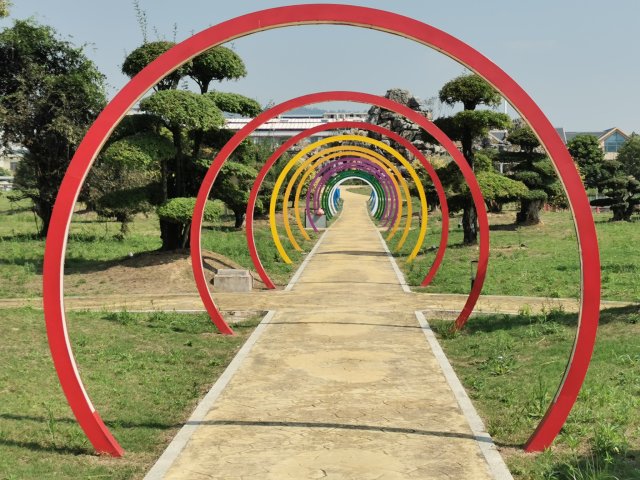Hello, time tunnel: An impressive section of route totaling at least 7,000 kilometers.
Photo: Volker Häring
Under the motto “As far as your feet can cycle” Cycle the Long March in China, which Mao undertook with his army in 1934/35. After a winter break, the second part begins on March 5th. How long is the Long March?
Christian Y. Schmidt: There are different information. Our Long March is about 7,000 kilometers long. We are based on two Englishmen who ran it in the mid-noughties and wrote a book about it: Ed Jocelyn and Andrew McEwen. At the end they said that the Long March was 6,800 kilometers long. The Chinese media immediately contradicted this, even if they thought their project was okay. But the official number in Chinese historiography is 11,000 kilometers, and that shouldn’t be changed.
Volker Häring: On the way we met a colonel from the People’s Liberation Army who was researching the Long March. He speaks of 14,000 kilometers. The Long March participant Otto Braun, whose trail we are following, writes that it was 10,000 kilometers.
Interview

Christian Schmidt (r.), born in 1956, is an ex-Maoist and ex-Titanic editor, writer and journalist. Most recently he published: »Corona Tests Beijing. Sixty-nine mass tests in China” (2023). Volker Häring, born in 1969, is a travel journalist, photographer and cycling holiday organizer. He most recently published “Cycling time on the Mecklenburg Lake District” (2023).
Why are there such variations?
Schmidt: Among other things, because there were actually three long marches by three armies, which also set off from different places. We are only following the first army with Mao, Otto Braun and other well-known people who ultimately determined the future fate of the country. But there is also controversy about this length of the route.
80,000 fighters set off and only one in ten of them arrived.
Schmidt: Yes, there were many battles and deaths. But wounded people were also left behind, as were groups of cadres to organize on the ground. Soldiers froze to death, drowned or deserted. You shouldn’t imagine that they marched in columns, that would have been too dangerous, as they were also attacked by planes. They marched not only through one valley, but also through the next valley; there was an advance guard and a rear guard. We follow Otto Braun, who was always with the leadership, which makes it a little easier.
How did he get into the Long March and get out again?
Schmidt: He was a professional revolutionary, born in 1900 and was already involved in the Munich Soviet Republic and also in the Central German uprising. He was in the military apparatus of the KPD and carried out command operations in Berlin. He then served time in prison and was freed in 1928 by Olga Benario, his lover at the time. They fled to Moscow together. In 1932, the Comintern sent him as a military advisor to China, where he headed the Red Army with Bo Gu, then general secretary of the Communist Party, and Zhou Enlai. Braun also helped initiate the Long March, which was initially a deportation and escape movement from the area in southern China that the communists controlled. Braun was removed from power by Mao on the march, but remained there until the end. This makes him the only foreigner to have taken part in the entire Long March, all the way to Yan’an. In 1939 he was suddenly recalled to Moscow. As a keeper of secrets, he was only allowed to travel to the GDR in 1954 after Stalin’s death. He lived there mainly as a freelance translator. It was not until 1964 that he was allowed to reveal his identity and role in China. In China, Braun is a famous historical figure as Li De – Li, the German. In Germany almost no one knows the man with the wild biography. We want to change that a bit with our tour and the book about it.
Häring: At the same time, of course, we also want to show how important the myth of the Long March still is for today’s China and what it looks like today where the Red Army marched. There is a lot of culture of remembrance there.
What?
Schmidt: Huge museums have been built in places where decisive conferences or major battles took place. Historic accommodations have been restored. We have already visited at least, I would say, 15 Mao residences and about the same number of Otto Braun residences. Monuments have been erected everywhere. We even came across an open-air stage where a Long March battle is reenacted in summer, with pyrotechnic effects.
Häring: This is a kind of red Way of St. James. There is now also a so-called “red tourism” that has been propagated since at least 2015. The first travel guides with which you could visit these revolutionary places were already available in the noughties. What there is not yet is a consistent line throughout history; there is still no corporate design for the Long March. But this is just developing.
And the roads are good?
Häring: 80 percent very good, better than in Germany, including cycle paths.
Why should people remember the Long March in China?
Häring: You should honor these deprivations and show that you still believe in something. An attitude that has become common among young people in today’s China. The spirit and essence of the Long March should be revived, these slogans can be encountered often.
What were your hardships?
Häring: In one day we had to drive around 120 kilometers because we suddenly found ourselves in an area that was apparently closed for military reasons. In the mountains of Guizhou, temperatures fell to five degrees, accompanied by heavy, continuous rain. We had to go through that. Then Christian’s bike broke down and it wasn’t immediately clear how we could get to the next small town.
Schmidt: But that was just the overture so far. Regarding what lies ahead of us now, I’ll read something from Otto Braun’s “Chinese Notes”: “Rapid rivers had to be forded, dense jungles and treacherous raised moors had to be crossed, mountain passes 4,000 to 5,000 meters high had to be overcome. Although summer had already begun, the temperatures barely rose above ten degrees. At night they sank almost to freezing point at the beginning of June. We won’t be on these passes in June, but in mid-April! Volker thinks that climate change would help us, but I’m not so sure about that. And these mountain passes certainly haven’t gotten any lower! Only the Yeti can actually breathe at such altitudes. I really hope that we somehow get used to the thin air. Otherwise that was my last interview today.
Häring: Christian is the pessimist among us. He always sees everything going wrong before we even try. And I’m the one who says, okay, the only thing that can’t be solved is death.
How many kilometers do you drive per day?
Schmidt: Minimum 30, maximum 110. That’s also due to the batteries.
So do you ride an e-bike?
Schmidt: Luckily. I insisted. I am 67 years old and have one foot in the grave. Originally we wanted to ride normal bikes. Then I would have crossed the Yangtze by now.
Häring: We drive between three and six hours. You definitely need a regular rest day. And not just for the body, but also for the mind. There are magnificent landscapes and also great cities or villages, you can’t just rush through them, you have to process them.
Schmidt: We get up at 6 a.m., then we start at around 10 a.m. and we arrive around 4 or 5 p.m. Volker then looks at the surroundings of the hotel. I lie flat for an hour and a half. Then dinner, diary dictation and social media. Every day on the first stage we have uploaded a video with text and photos on Insta. Free time begins at 11 p.m., which means mattress listening duty until 6 a.m. in the morning. And during breaks on the road we write postcards.
I thought this medium was dying out?
Schmidt: On the contrary, this is important for our financing. Anyone who transfers 20 euros to a PayPal account will receive a limited edition printed Long March postcard from China, handwritten of course. With beautiful, rare stamps, because they are actually not that easy to find because stamps are hardly used in China anymore. They are rationed at post offices.
Are there other sources of income for your Long March?
Schmidt: We have an advance from Ullsteinverlag and a grant from the Rosa-Luxemburg-Stiftung, but that’s not enough front and center. We have to pay for three meals and overnight accommodation every day.
Häring: We also sell T-shirts and mugs. The t-shirt costs 40 euros, the mug costs 30. And then we still have to write the book for six months.
Have you lost weight on your tour so far?
Häring: No, we always eat Snickers on the bike, which is available everywhere in China. And we drink cola because of the sugar, which is important. I would never eat either in Germany.
Schmidt: Ah, that just gives me an idea: Volker, we could contact Mars Inc., the manufacturer of Snickers, so that they could sponsor us money for the second stage? Maybe there would even be oxygen bottles for extreme altitudes?
Here you can watch the Long March of both cyclists and Chinese athletes on Youtube, on Facebook and on Instagram track.
#ndstays – Get active and order a promotional package

Regardless of whether it is pubs, cafés, festivals or other meeting places – we want to become more visible and reach everyone who values independent journalism with an attitude. We have put together a campaign package with stickers, flyers, posters and buttons that you can use to get active and support your newspaper.
To the promotional package
sbobet88 link slot demo sbobet sbobet88
